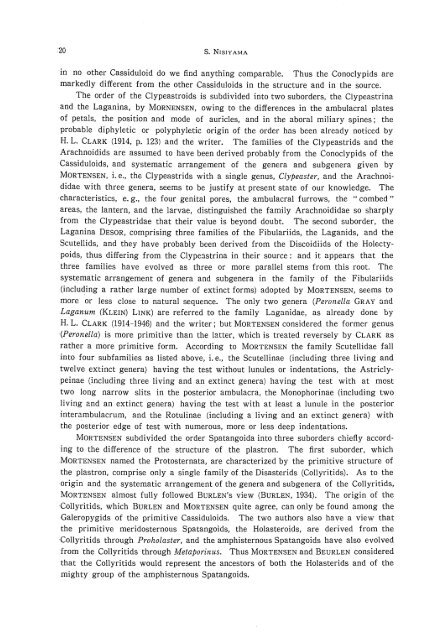the echinoid fauna from japan and adjacent regions part i
the echinoid fauna from japan and adjacent regions part i
the echinoid fauna from japan and adjacent regions part i
Create successful ePaper yourself
Turn your PDF publications into a flip-book with our unique Google optimized e-Paper software.
20 S. NISIYAMA<br />
in no o<strong>the</strong>r Cassiduloid do we find anything comparable. Thus <strong>the</strong> Conoclypids are<br />
markedly different <strong>from</strong> <strong>the</strong> o<strong>the</strong>r Cassiduloids in <strong>the</strong> structure <strong>and</strong> in· <strong>the</strong> source.<br />
The order of <strong>the</strong> Clypeastroids is subdivided into two suborders, <strong>the</strong> Clypeastrina<br />
<strong>and</strong> <strong>the</strong> Laganina, by MORNENSEN, owing to <strong>the</strong> differences in <strong>the</strong> ambulacral plates<br />
of petals, <strong>the</strong> position <strong>and</strong> mode of auricles, <strong>and</strong> in <strong>the</strong> aboral miliary spines; <strong>the</strong><br />
probable diphyletic or polyphyletic origin of <strong>the</strong> order has been already noticed by<br />
H. L. CLARK (1914, p. 123) <strong>and</strong> <strong>the</strong> writer. The families of <strong>the</strong> Clypeastrids <strong>and</strong> <strong>the</strong><br />
Arachnoidids are assumed to have been derived probably <strong>from</strong> <strong>the</strong> Conoclypids of <strong>the</strong><br />
Cassiduloids, <strong>and</strong> systematic arrangement of <strong>the</strong> genera <strong>and</strong> subgenera given by<br />
MORTENSEN, i. e., <strong>the</strong> Clypeastrids with a single genus, Clypeaster, <strong>and</strong> <strong>the</strong> Arachnoididae<br />
with three genera, seems to be justify at present state of our knowledge. The<br />
characteristics, e. g., <strong>the</strong> four genital pores, <strong>the</strong> ambulacral furrows, <strong>the</strong> "combed"<br />
areas, <strong>the</strong> lantern, <strong>and</strong> <strong>the</strong> larvae, distinguished <strong>the</strong> family Arachnoididae so sharply<br />
<strong>from</strong> <strong>the</strong> Clypeastridae that <strong>the</strong>ir value is beyond doubt. The second suborder, <strong>the</strong><br />
Laganina DESOR, comprising three families of <strong>the</strong> Fibulariids, <strong>the</strong> Laganids, <strong>and</strong> <strong>the</strong><br />
Scutellids, <strong>and</strong> <strong>the</strong>y have probably been derived <strong>from</strong> <strong>the</strong> Discoidiids of <strong>the</strong> Holectypoids,<br />
thus differing <strong>from</strong> <strong>the</strong> Clypeastrina in <strong>the</strong>ir source: <strong>and</strong> it appears that <strong>the</strong><br />
three families have evolved as three or more parallel stems <strong>from</strong> this root. The<br />
systematic arrangement of genera <strong>and</strong> subgenera in <strong>the</strong> family of <strong>the</strong> Fibulariids<br />
(including a ra<strong>the</strong>r large number of extinct forms) adopted by MORTENSEN, seems to<br />
more or less close to natural sequence. The only two genera (Peronella GRAY <strong>and</strong><br />
Laganum (KLEIN) LINK) are referred to <strong>the</strong> family Laganidae, as already done by<br />
H. L. CLARK (1914-1946) <strong>and</strong> <strong>the</strong> writer; but MORTENSEN considered <strong>the</strong> former genus<br />
(Peronella) is more primitive than <strong>the</strong> latter, which is treated reversely by CLARK as<br />
ra<strong>the</strong>r a more primitive form. According to MORTENSEN <strong>the</strong> family Scutellidae fall<br />
into four subfamilies as listed above, i. e., <strong>the</strong> Scutellinae (including three living <strong>and</strong><br />
twelve extinct genera) having <strong>the</strong> test without lunules or indentations, <strong>the</strong> Astriclypeinae<br />
(including three living <strong>and</strong> an extinct genera) having <strong>the</strong> test with at most<br />
two long narrow slits in <strong>the</strong> posterior ambulacra, <strong>the</strong> Monophorinae (including two<br />
living <strong>and</strong> an extinct genera) having <strong>the</strong> test with at least a lunule in <strong>the</strong> posterior<br />
interambulacrum, <strong>and</strong> <strong>the</strong> Rotulinae (including a living <strong>and</strong> an extinct genera) with<br />
<strong>the</strong> posterior edge of test with numerous, more or less deep indentations.<br />
MORTENSEN subdivided <strong>the</strong> order Spatangoida into three suborders chiefly according<br />
to <strong>the</strong> difference of <strong>the</strong> structure of <strong>the</strong> plastron. The first suborder, which<br />
MORTENSEN named <strong>the</strong> Protosternata, are characterized by <strong>the</strong> primitive structure of<br />
<strong>the</strong> plastron, comprise only a single family of <strong>the</strong> Disasterids (Collyritids). As to <strong>the</strong><br />
origin <strong>and</strong> <strong>the</strong> systematic arrangement of <strong>the</strong> genera <strong>and</strong> subgenera of <strong>the</strong> Collyritids,<br />
MORTENSEN almost fully followed BURLEN'S view (BURLEN, 1934). The origin of <strong>the</strong><br />
Collyritids, which BURLEN <strong>and</strong> MORTENSEN quite agree, can only be found among <strong>the</strong><br />
Galeropygids of <strong>the</strong> primitive Cassiduloids. The two authors also have a view that<br />
<strong>the</strong> primitive meridosternous Spatangoids, <strong>the</strong> Holasteroids, are derived <strong>from</strong> <strong>the</strong><br />
Collyritids through Proholaster, <strong>and</strong> <strong>the</strong> amphisternous Spatangoids have also evolved<br />
<strong>from</strong> <strong>the</strong> Collyritids through Metaporinus. Thus MORTENSEN <strong>and</strong> BEURLEN considered<br />
that <strong>the</strong> Collyritids would represent <strong>the</strong> ancestors of both <strong>the</strong> Holasterids <strong>and</strong> of <strong>the</strong><br />
mighty group of <strong>the</strong> amphisternous Spatangoids.












